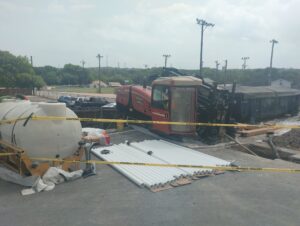Texas Dry Cleaner Horizontal SVE Wells
Leached solvents from two distinct dry cleaner locations has polluted private water supply wells and created an extensive groundwater contaminant plume at a site near San Antonio, Texas. The problem was first identified in the early 2000’s, and with responsible parties insolvent, the site has been added to the National Priority List (i.e., Superfund). After years of investigation and characterization, the Final Remedial Design is being implemented, and includes a number of horizontal Soil Vapor Extraction wells.

30AT with well materials ready for install
Our first effort at the site was the installation of a single horizontal SVE well in the primary source area in 2019, and just last month we returned to install three additional horizontal SVE wells. One was added to the primary source area and two more wells were added at the secondary source area, about a half mile away.
These wells are a little unusual, in that most SVE wells we install are relatively shallow and in soils, but all of these wells were somewhat deep, with 100 foot long screens trending at approximately 35 feet below ground, and installed in bedrock (the Austin Chalk). The wells were over 250 feet long and constructed of custom slotted, 3-inch diameter PVC. Each well trended underneath the former dry cleaning buildings.
The bores were advanced using one of our smaller dual-rod, all-terrain drill rigs, a Ditch Witch 30AT. These rigs use a dual-rod drilling system, where the inner rod provides the rotary force and torque to spin a rock-cutting bit, and the outer rod supports and orients a bent sub near the bit, enabling the driller to orient the bend in the desired direction for steering. This combination allows these smaller rigs to effectively drill and navigate through rock, something that otherwise requires a bigger drilling operation. Ultimately, this means a smaller bore can be drilled, with less drilling waste, less mud cost, and less time on site.